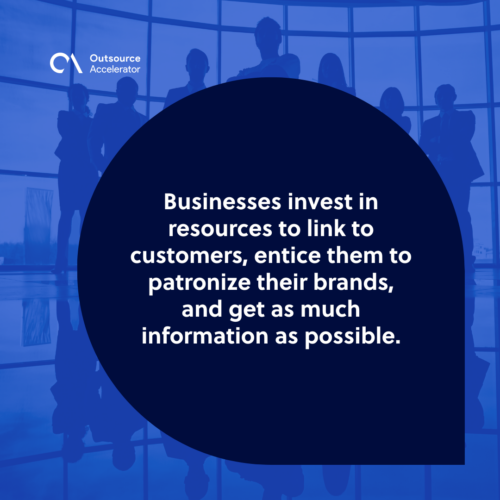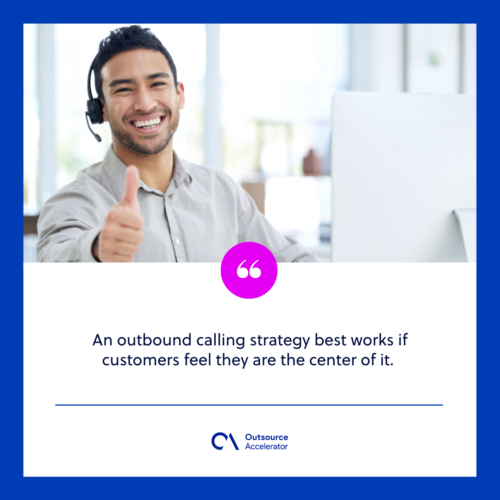5 tips to revitalize your outbound calling strategy

Establishing rapport with clients is as hard as maintaining good customer relationships. It takes time, patience, and hard work to earn their trust and support.
Traditionally, call center agents receive the cold shoulder during outbound calls. In extreme cases, they experience untoward situations with angry clients.
Outbound calls are indeed quite a challenge. However, with an excellent outbound calling strategy, the stress and difficulties can be managed or avoided.
What makes up a good outbound calling strategy? What are surefire ways to elicit good customer response?
This article identifies six tried and tested strategies that can put your business on top.
Why is outbound calling strategy important?
Technological developments have made the commercial ecosystem more modern, remote, and tech-driven. This has made outbound marketing the bread and butter of the new system.
Businesses invest in resources to link to customers, entice them to patronize their brands, and get as much information as possible. In fact, outbound calling is used for a variety of reasons. Some use it for marketing, data collection, or sales.
Whatever the purpose is, outbound calling helps enterprises to achieve their goals and objectives more realistically and efficiently.
With the advent of cloud telephony, outbound calling strategy has emerged. The development of new approaches has spurred to elicit the attention of clients.
But not all outbound calling strategies are successful. Most fail due to the lack of due diligence, a proper understanding of the market, and correct approaches.
Hence, in creating an outbound calling strategy, certain factors, which are outlined in the next section, must be taken into account.

5 hacks for a successful outbound calling strategy
Below are five of the most useful ways companies can use in developing their outbound calling strategy:
1. Make it clear what success looks like
Set clear goals and metrics that the entire team understands. Having a clear grasp of how the strategy works can greatly benefit the team as they can know where to improve their performance.
For instance, the following metrics must have clear, measurable, and transparent goals:
- Average handle time – agents must understand that the shorter they can accomplish and process calls, the better it is.
- Conversion rate – a basic measure of successful lead conversion that agents could accomplish in a time period.
- First call close – a winning sales strategy that indicates the rate of successful sales closure during first calls.
These metrics would not be attainable without proper execution. Training is essential to ensure that agents are always prepared for it.

2. Improve! Encourage! Inspire!
Talents and skills are a given. Regular periodic training programs can ensure that agents are in top shape and their skills are nurtured.
However, agents do not just stay because of the training they get. It is equally important to make them feel valued and appreciated for their hard work.
For any successful sales conversion, celebrate it. For hitting the monthly quota, recognize it. If the entire company is at the peak of its performance, shout about it.
Provide generous incentives, prizes, and commissions that foster healthy team competition. It will make the whole process fun and make teams focused on a certain goal.
3. Collectively develop natural and well–thought spiels
Customers are intelligent. They know when a remark is scripted or sincere. Hence, spiels can either make or break the conversion of sales.
The best way to manage this is to ensure that your employees are equipped to handle conversations as freely as possible. However, not everyone is articulate.
This is where scripts come in handy. The best way to create engaging spiels is to collaborate with the agents. They know more about what happens on the ground.
If scripts can be tailor-fitted to where agents’ are most comfortable while observing corporate guidelines, customers would not feel lines are rehearsed.
The better the perception of the clients, the best it is for the interests of the business.

4. Engage. Personalize. Make it all about the client
An outbound calling strategy best works if customers feel they are the center of it. If they do not see anything valuable to it, they will drop the call right away.
The first seven seconds of the call matter. Grab the customer’s attention and make sure to create a space for conversation.
It is also important to address them by their first name and deliver a short yet interactive pitch.
If they are in a rush, try to get a new schedule for a follow-up call.
5. Feedback matters
A feedback loop is important for any organization to grow. It helps the team gauge their current performance and address any loopholes identified.
It also ensures that the initial goals and objectives set at the onset are met. If there are any lapses, it can help organizations determine the measures to ensure smoother execution in the future.
With a constant feedback culture, excellence in service can be obtained. Employees are more conscious of their room for improvement, while the management can invest in equipment and resources to help them improve.
Building an outbound calling strategy for your company
As the saying goes, there are a thousand ways to skin a cat. The same goes for curating an outbound calling strategy.
Companies can identify and look for ways to improve their outbound approaches that best reflect the context and situation of their businesses.
The most important aspect of developing an outbound calling strategy is that the customer must be at the center from start to finish.







 Independent
Independent




